Gil Zussman
Fair Dynamic Spectrum Access via Fully Decentralized Multi-Agent Reinforcement Learning
Mar 31, 2025
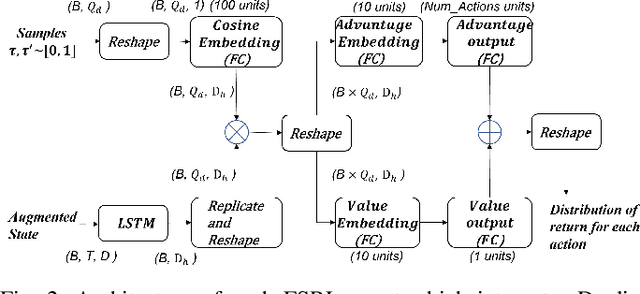
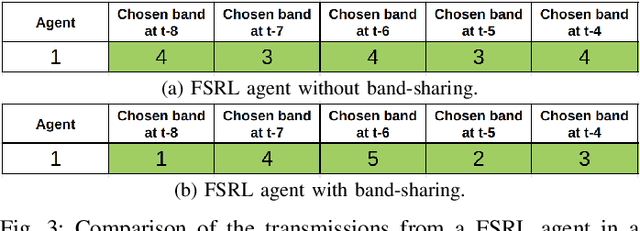

Abstract:We consider a decentralized wireless network with several source-destination pairs sharing a limited number of orthogonal frequency bands. Sources learn to adapt their transmissions (specifically, their band selection strategy) over time, in a decentralized manner, without sharing information with each other. Sources can only observe the outcome of their own transmissions (i.e., success or collision), having no prior knowledge of the network size or of the transmission strategy of other sources. The goal of each source is to maximize their own throughput while striving for network-wide fairness. We propose a novel fully decentralized Reinforcement Learning (RL)-based solution that achieves fairness without coordination. The proposed Fair Share RL (FSRL) solution combines: (i) state augmentation with a semi-adaptive time reference; (ii) an architecture that leverages risk control and time difference likelihood; and (iii) a fairness-driven reward structure. We evaluate FSRL in more than 50 network settings with different number of agents, different amounts of available spectrum, in the presence of jammers, and in an ad-hoc setting. Simulation results suggest that, when we compare FSRL with a common baseline RL algorithm from the literature, FSRL can be up to 89.0% fairer (as measured by Jain's fairness index) in stringent settings with several sources and a single frequency band, and 48.1% fairer on average.
Channel and Spectrum Consumption Models for Urban Outdoor-to-Outdoor 28 GHz Wireless
Mar 14, 2025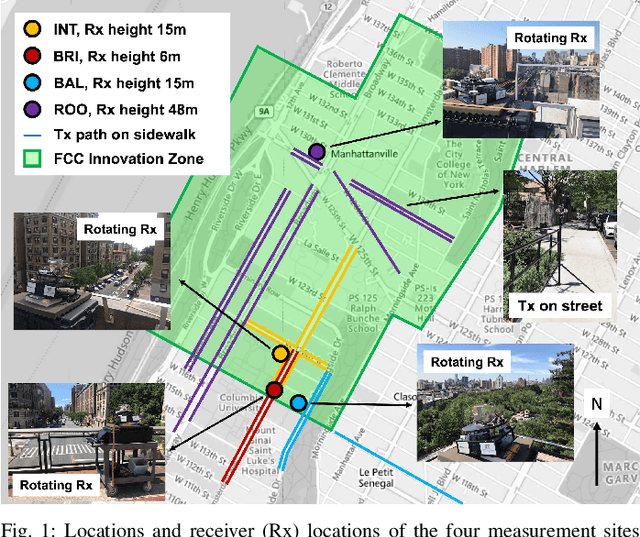
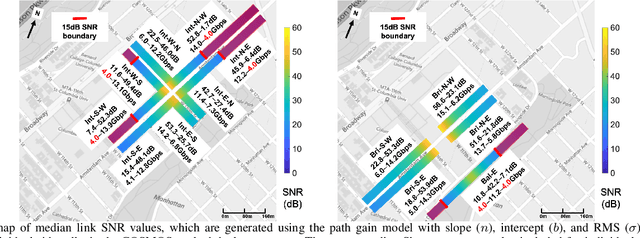
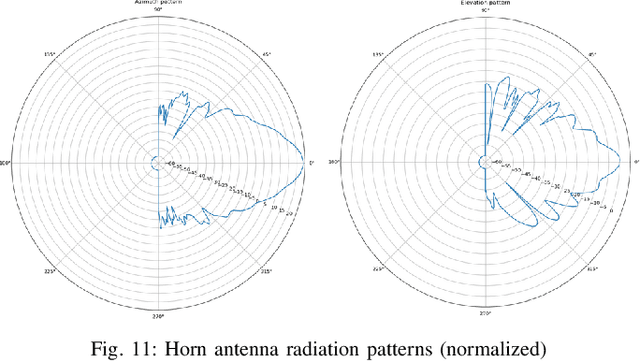
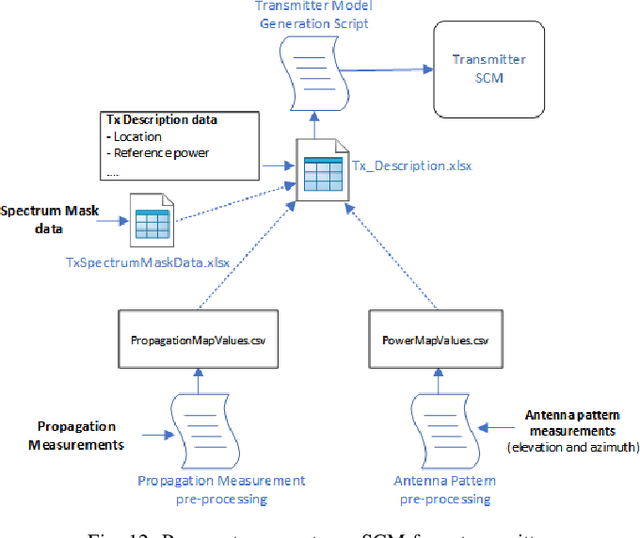
Abstract:Next generation wireless and mobile networks will utilize millimeter-wave (mmWave) communication to achieve significantly increased data rates. However, since mmWave radio signals experience high path loss, the operation of mmWave networks will require accurate channel models designed for specific deployment sites. In this paper, we focus on the deployment area of the PAWR COSMOS testbed in New York City and report extensive 28 GHz channel measurements. These include over 46 million power measurements collected from over 3,000 links on 24 sidewalks at 4 different sites and in different settings. Using these measurements, we study the effects of the setup and environments (e.g., transmitter height and seasonal effects). We then discuss the obtained path gain values and their fitted lines, and the resulting effective azimuth beamforming gain. Based on these results, we also study the link SNR values that can be supported on individual sidewalks and the corresponding theoretically achievable data rates. Finally, we develop a process to transform the measurements and generate Spectrum Consumption Models (SCMs) based on the IEEE 1900.5.2 standard. The generated SCMs facilitate the evaluation of spectrum sharing and interference management scenarios since they capture all the directional propagation effects reflected in the measurements and provide a way to easily share the main propagation characterization results derived from the measurements. We believe that the results can inform the COSMOS testbed deployment process and provide a benchmark for other deployment efforts in dense urban areas.
The Streetscape Application Services Stack (SASS): Towards a Distributed Sensing Architecture for Urban Applications
Nov 29, 2024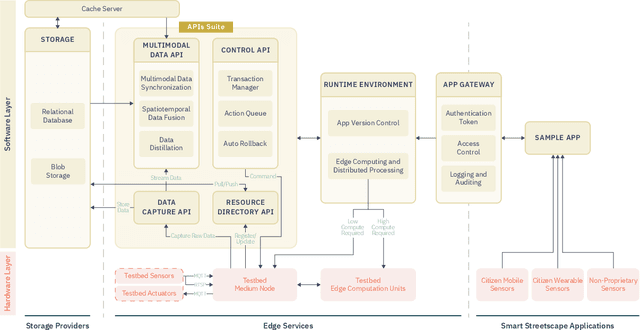



Abstract:As urban populations grow, cities are becoming more complex, driving the deployment of interconnected sensing systems to realize the vision of smart cities. These systems aim to improve safety, mobility, and quality of life through applications that integrate diverse sensors with real-time decision-making. Streetscape applications-focusing on challenges like pedestrian safety and adaptive traffic management-depend on managing distributed, heterogeneous sensor data, aligning information across time and space, and enabling real-time processing. These tasks are inherently complex and often difficult to scale. The Streetscape Application Services Stack (SASS) addresses these challenges with three core services: multimodal data synchronization, spatiotemporal data fusion, and distributed edge computing. By structuring these capabilities as clear, composable abstractions with clear semantics, SASS allows developers to scale streetscape applications efficiently while minimizing the complexity of multimodal integration. We evaluated SASS in two real-world testbed environments: a controlled parking lot and an urban intersection in a major U.S. city. These testbeds allowed us to test SASS under diverse conditions, demonstrating its practical applicability. The Multimodal Data Synchronization service reduced temporal misalignment errors by 88%, achieving synchronization accuracy within 50 milliseconds. Spatiotemporal Data Fusion service improved detection accuracy for pedestrians and vehicles by over 10%, leveraging multicamera integration. The Distributed Edge Computing service increased system throughput by more than an order of magnitude. Together, these results show how SASS provides the abstractions and performance needed to support real-time, scalable urban applications, bridging the gap between sensing infrastructure and actionable streetscape intelligence.
Boundless: Generating Photorealistic Synthetic Data for Object Detection in Urban Streetscapes
Sep 04, 2024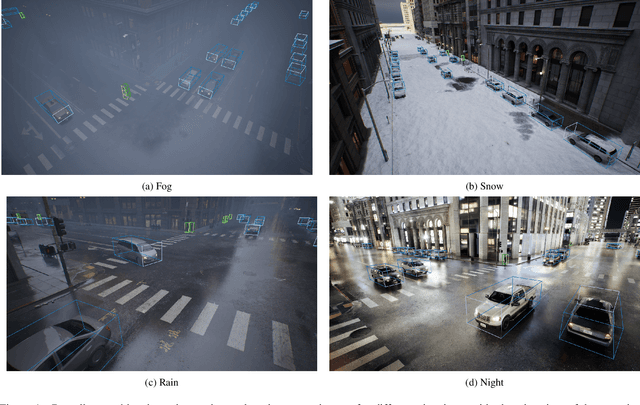


Abstract:We introduce Boundless, a photo-realistic synthetic data generation system for enabling highly accurate object detection in dense urban streetscapes. Boundless can replace massive real-world data collection and manual ground-truth object annotation (labeling) with an automated and configurable process. Boundless is based on the Unreal Engine 5 (UE5) City Sample project with improvements enabling accurate collection of 3D bounding boxes across different lighting and scene variability conditions. We evaluate the performance of object detection models trained on the dataset generated by Boundless when used for inference on a real-world dataset acquired from medium-altitude cameras. We compare the performance of the Boundless-trained model against the CARLA-trained model and observe an improvement of 7.8 mAP. The results we achieved support the premise that synthetic data generation is a credible methodology for training/fine-tuning scalable object detection models for urban scenes.
Data-Driven Traffic Simulation for an Intersection in a Metropolis
Aug 01, 2024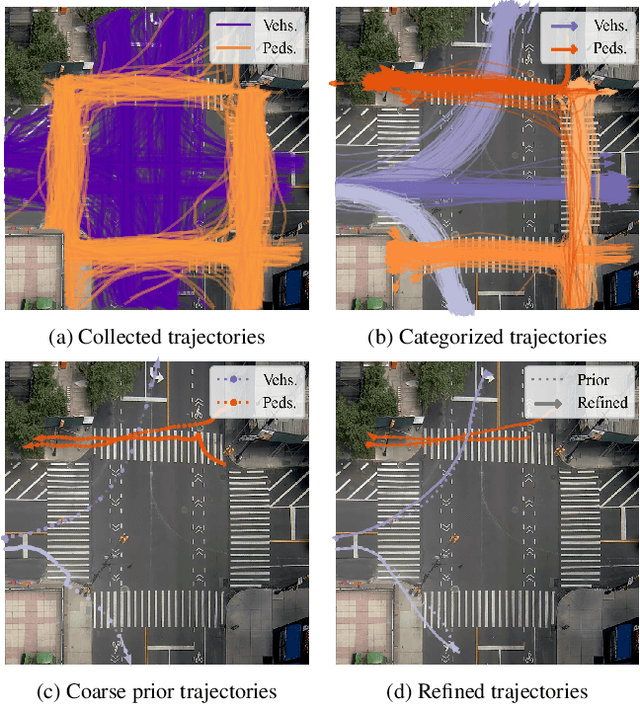
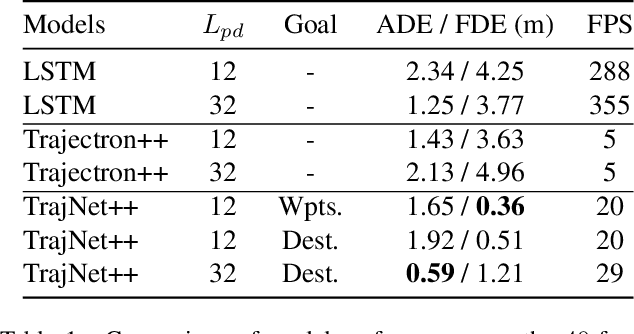
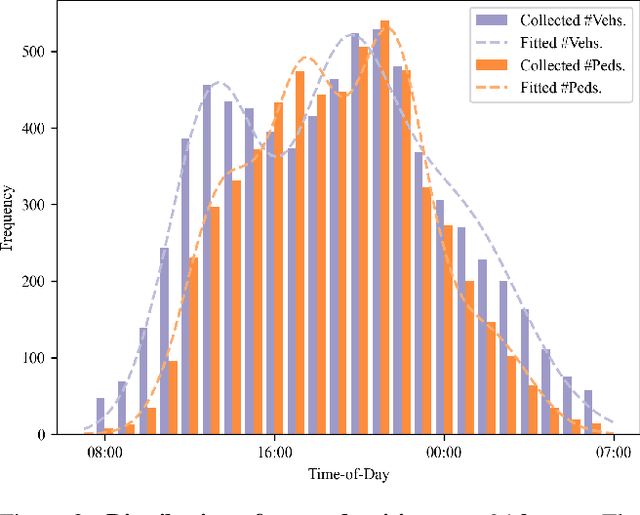
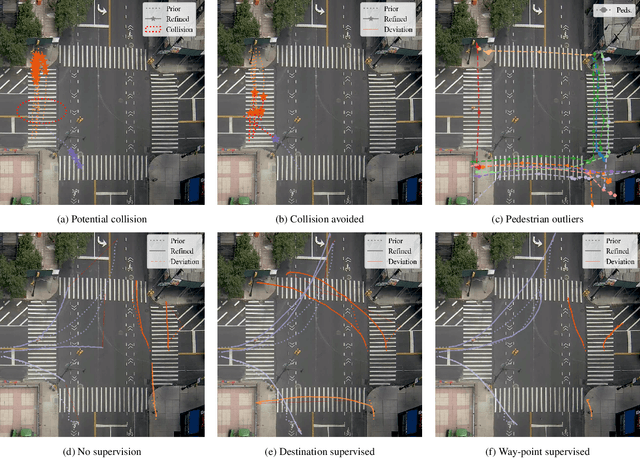
Abstract:We present a novel data-driven simulation environment for modeling traffic in metropolitan street intersections. Using real-world tracking data collected over an extended period of time, we train trajectory forecasting models to learn agent interactions and environmental constraints that are difficult to capture conventionally. Trajectories of new agents are first coarsely generated by sampling from the spatial and temporal generative distributions, then refined using state-of-the-art trajectory forecasting models. The simulation can run either autonomously, or under explicit human control conditioned on the generative distributions. We present the experiments for a variety of model configurations. Under an iterative prediction scheme, the way-point-supervised TrajNet++ model obtained 0.36 Final Displacement Error (FDE) in 20 FPS on an NVIDIA A100 GPU.
Constellation Dataset: Benchmarking High-Altitude Object Detection for an Urban Intersection
Apr 25, 2024



Abstract:We introduce Constellation, a dataset of 13K images suitable for research on detection of objects in dense urban streetscapes observed from high-elevation cameras, collected for a variety of temporal conditions. The dataset addresses the need for curated data to explore problems in small object detection exemplified by the limited pixel footprint of pedestrians observed tens of meters from above. It enables the testing of object detection models for variations in lighting, building shadows, weather, and scene dynamics. We evaluate contemporary object detection architectures on the dataset, observing that state-of-the-art methods have lower performance in detecting small pedestrians compared to vehicles, corresponding to a 10% difference in average precision (AP). Using structurally similar datasets for pretraining the models results in an increase of 1.8% mean AP (mAP). We further find that incorporating domain-specific data augmentations helps improve model performance. Using pseudo-labeled data, obtained from inference outcomes of the best-performing models, improves the performance of the models. Finally, comparing the models trained using the data collected in two different time intervals, we find a performance drift in models due to the changes in intersection conditions over time. The best-performing model achieves a pedestrian AP of 92.0% with 11.5 ms inference time on NVIDIA A100 GPUs, and an mAP of 95.4%.
Design and Testbed Deployment of Frequency-Domain Equalization Full Duplex Radios
Jan 31, 2024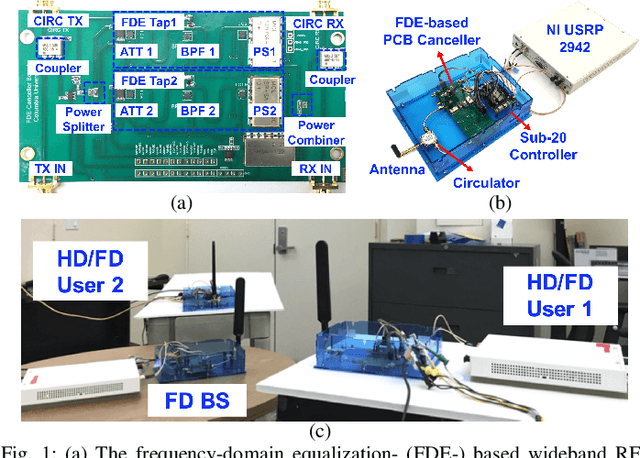
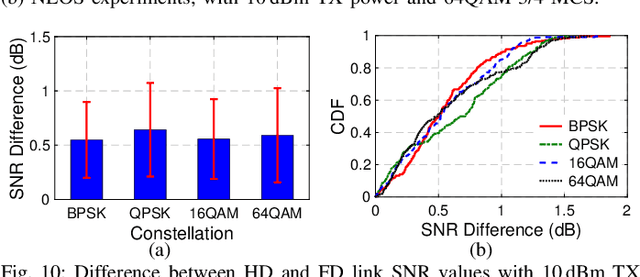
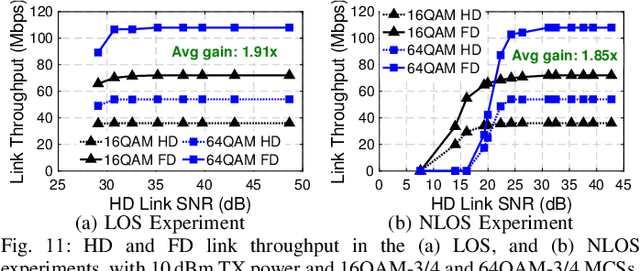

Abstract:Full-duplex (FD) wireless can significantly enhance spectrum efficiency but requires effective self-interference (SI) cancellers. RF SI cancellation (SIC) via frequency-domain equalization (FDE), where bandpass filters channelize the SI, is suited for integrated circuits (ICs). In this paper, we explore the limits and higher layer challenges associated with using such cancellers. We evaluate the performance of a custom FDE-based canceller using two testbeds; one with mobile FD radios and the other with upgraded, static FD radios in the PAWR COSMOS testbed. The latter is a lasting artifact for the research community, alongside a dataset containing baseband waveforms captured on the COSMOS FD radios, facilitating FD-related experimentation at the higher networking layers. We evaluate the performance of the FDE-based FD radios in both testbeds, with experiments showing 95 dB overall achieved SIC (52 dB from RF SIC) across 20 MHz bandwidth, and an average link-level FD rate gain of 1.87x. We also conduct experiments in (i) uplink-downlink networks with inter-user interference, and (ii) heterogeneous networks with half-duplex and FD users. The experimental FD gains in the two types of networks depend on the users' SNR values and the number of FD users, and are 1.14x-1.25x and 1.25x-1.73x, respectively, confirming previous analytical results.
Protection Against Graph-Based False Data Injection Attacks on Power Systems
Apr 21, 2023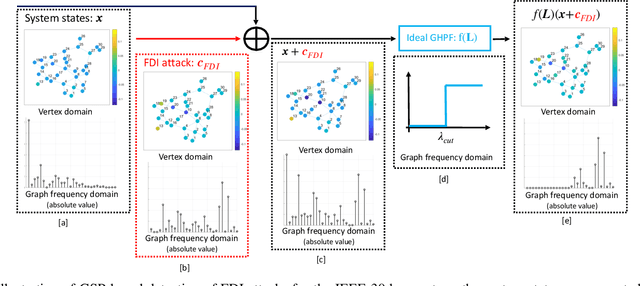
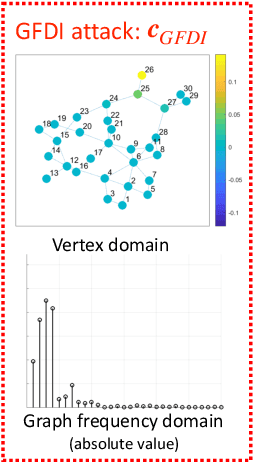
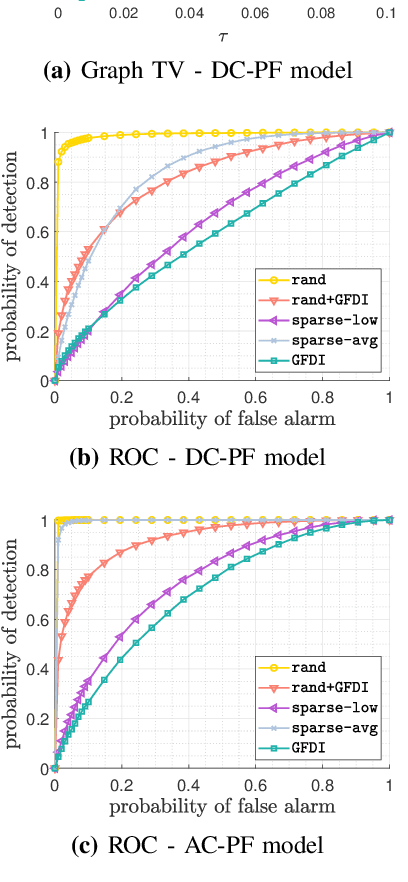
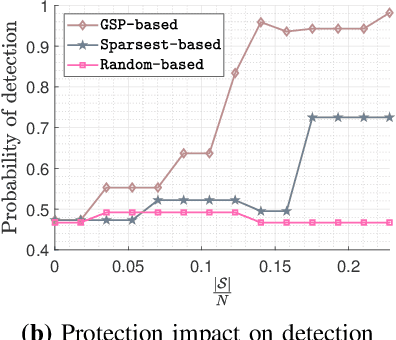
Abstract:Graph signal processing (GSP) has emerged as a powerful tool for practical network applications, including power system monitoring. By representing power system voltages as smooth graph signals, recent research has focused on developing GSP-based methods for state estimation, attack detection, and topology identification. Included, efficient methods have been developed for detecting false data injection (FDI) attacks, which until now were perceived as non-smooth with respect to the graph Laplacian matrix. Consequently, these methods may not be effective against smooth FDI attacks. In this paper, we propose a graph FDI (GFDI) attack that minimizes the Laplacian-based graph total variation (TV) under practical constraints. In addition, we develop a low-complexity algorithm that solves the non-convex GDFI attack optimization problem using ell_1-norm relaxation, the projected gradient descent (PGD) algorithm, and the alternating direction method of multipliers (ADMM). We then propose a protection scheme that identifies the minimal set of measurements necessary to constrain the GFDI output to high graph TV, thereby enabling its detection by existing GSP-based detectors. Our numerical simulations on the IEEE-57 bus test case reveal the potential threat posed by well-designed GSP-based FDI attacks. Moreover, we demonstrate that integrating the proposed protection design with GSP-based detection can lead to significant hardware cost savings compared to previous designs of protection methods against FDI attacks.
Outdoor-to-Indoor 28 GHz Wireless Measurements in Manhattan: Path Loss, Environmental Effects, and 90% Coverage
May 19, 2022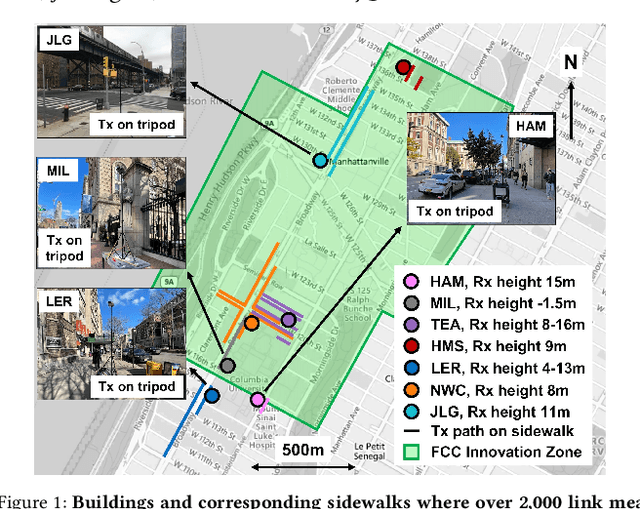

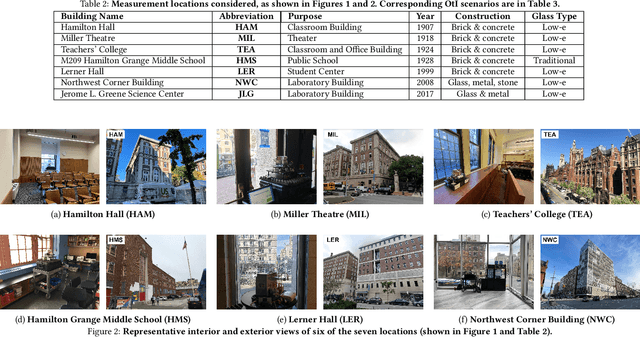
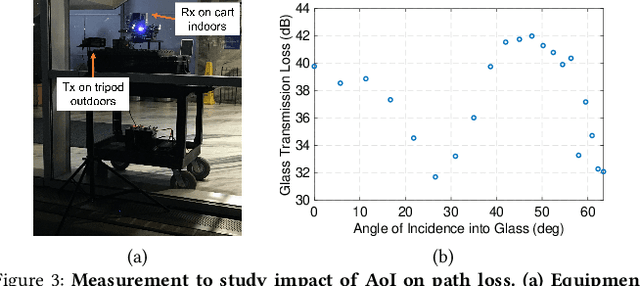
Abstract:Outdoor-to-indoor (OtI) signal propagation further challenges the already tight link budgets at millimeter-wave (mmWave). To gain insight into OtI mmWave scenarios at 28 GHz, we conducted an extensive measurement campaign consisting of over 2,200 link measurements. In total, 43 OtI scenarios were measured in West Harlem, New York City, covering seven highly diverse buildings. The measured OtI path gain can vary by up to 40 dB for a given link distance, and the empirical path gain model for all data shows an average of 30 dB excess loss over free space at distances beyond 50 m, with an RMS fitting error of 11.7 dB. The type of glass is found to be the single dominant feature for OtI loss, with 20 dB observed difference between empirical path gain models for scenarios with low-loss and high-loss glass. The presence of scaffolding, tree foliage, or elevated subway tracks, as well as difference in floor height are each found to have an impact between 5-10 dB. We show that for urban buildings with high-loss glass, OtI coverage can support 500 Mbps for 90% of indoor user equipment (UEs) with a base station (BS) antenna placed up to 49 m away. For buildings with low-loss glass, such as our case study covering multiple classrooms of a public school, data rates over 2.5/1.2 Gbps are possible from a BS 68/175 m away from the school building, when a line-of-sight path is available. We expect these results to be useful for the deployment of mmWave networks in dense urban environments as well as the development of relevant scheduling and beam management algorithms.
Smart City Intersections: Intelligence Nodes for Future Metropolises
May 13, 2022


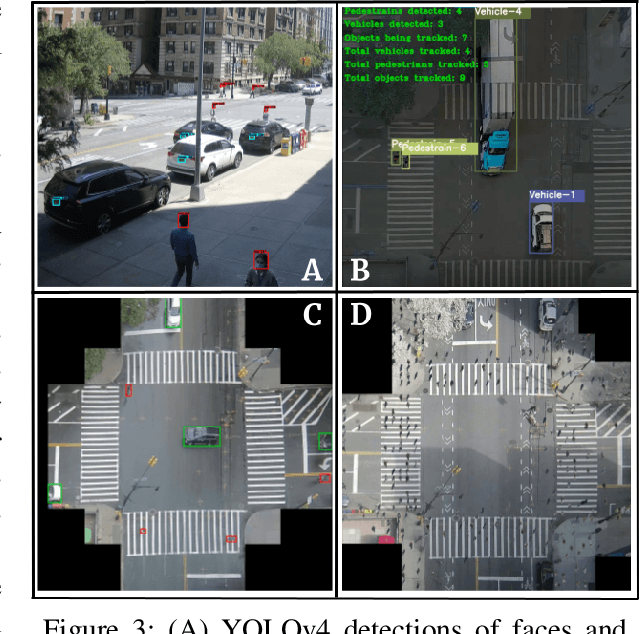
Abstract:Traffic intersections are the most suitable locations for the deployment of computing, communications, and intelligence services for smart cities of the future. The abundance of data to be collected and processed, in combination with privacy and security concerns, motivates the use of the edge-computing paradigm which aligns well with physical intersections in metropolises. This paper focuses on high-bandwidth, low-latency applications, and in that context it describes: (i) system design considerations for smart city intersection intelligence nodes; (ii) key technological components including sensors, networking, edge computing, low latency design, and AI-based intelligence; and (iii) applications such as privacy preservation, cloud-connected vehicles, a real-time "radar-screen", traffic management, and monitoring of pedestrian behavior during pandemics. The results of the experimental studies performed on the COSMOS testbed located in New York City are illustrated. Future challenges in designing human-centered smart city intersections are summarized.
 Add to Chrome
Add to Chrome Add to Firefox
Add to Firefox Add to Edge
Add to Edge